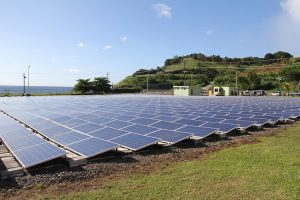Only Small Percentage of COVID-19 Recovery Allocated to Green Initiatives
 12 Maret 2021
12 Maret 2021

Photovoltaic panels on St. Vincent and the Grenadines. Of the trillions of dollars set aside for COVID-19 recovery, a small percentage has been used in green recovery initiatives according to a United Nations Environment Programme (UNEP) report. Credit: Kenton X. Chance/IPS
By Samira Sadeque
UNITED NATIONS, Mar 11 2021 (IPS)
Last year, only $368 billion of a $14.6tn budget geared towards COVID-19 recovery measures across the world’s largest 50 countries took into account green recovery initiatives, according to a report launched yesterday, Mar. 10.
“Are we building back better?” by the Global Recovery Observatory, an initiative led by the Oxford University Economic Recovery Project (OUERP), and supported by the United Nations Environment Programme (UNEP) was launched during a panel talk where global leaders who discussed measures taken to recover from the COVID-19 pandemic that are favourable to the climate.
“With growing climate instability, rising inequality, and worsening global poverty (World Bank, 2021), it is crucial that governments build back better through a green and inclusive recovery,” read a part of the report.
UNEP Executive Director Inger Andersen addressed the trillions in the budget for post-COVID-19 recovery.
“We are taking extraordinary amounts out of the pockets of the future — because these are borrowed monies — so let’s not do that with the engine of driving further environmental destruction,” she said.
Kristalina Georgieva, Managing Director of the International Monetary Fund (IMF), which also supported the report, was on the panel and highlighted the crucial importance of including climate action in the budget for development after the pandemic. The role of climate action is “indispensable” in IMF’s work, she said.
“We cannot have microeconomic and financial stability without environmental and social sustainability and these are issues we need to learn fast how to integrate in economic policy,” Georgieva said.
She was echoing one of the key recommendations in the report that called for a higher investment in research and development (R&D) of understanding economic impacts and requirements of green initiatives.
In some cases, some of the impact may not even be seen in the immediate aftermath of the implementation, the report noted.
“The new technologies developed through such programmes will be necessary to meet climate commitments, particularly in hard-to-abate sectors such as heavy transport, industry, and agriculture,” the report claimed.
In the COVID-19 recovery packages, among other green initiatives, the R&D sector was allotted the lowest amount — $28.9 bn. This, the authors claimed, could potentially be because of the long time it takes to see results in these types of investments.
This likely means that “governments that are looking for tangible change on the scale of months may prioritise different policies in the short-term,” the report added.
But Andersen of UNEP said that countries could learn from what others were doing to help shape their own approach.
She said the partnership between the Observatory and UNEP, and their findings would allow countries “to check what neighbours are doing” and “see a menu of options”.
“Brazil is going to have different solutions to Guinea Bissau but it’s about doing elements that can lead us in the right directions,” Andersen said.
Moderator Nozipho Tshabalala said: “This is not about comparing between countries, but about galvanising momentum to look at what others are spending and the impact of that.”
Economist and Nobel Laureate Professor Joseph Stiglitz also spoke at the panel and pointed out various tools that need to be taken into account: how the money is allocated, how the projects are designed to make sure that in the designs there are concerns about inequality and the environment.
“These are not contradictory objectives but complementary objectives,” he said.
Georgieva of IMF brought the focus to factors important for the IMF to take into account as they plan.
“In our function of looking at the health of national economies and the world economy, we must integrate climate change,” she said.
“We take into account bulk opportunities to reduce the risk of climate change in the future — such as, how to bring down emissions, how to integrate that in economic development, and also factoring in the opportunity for green growth,” she added. “How can we create more jobs and better opportunities by investing money the right way?”
She emphasised that it’s crucial for those in the finance industry to be aware of the climate risks to financial stability.
“There are transitional risks if the economy shifts away from carbon intensive industries and the financial system is slow to adapt to that — that could be a massive shock,” she said.
She added that financial institutions should further be aware of the exposure of the industry to the climate crisis.
“We have to integrate climate in our capacity development; central banks and finance ministries ought to be better equipped to factor sustainability in their decision making,” she said.
She also highlighted the importance of data collection.
“We are now working on bringing carbon intensity in quarter economic reports,” she said, adding that it’s crucial information for countries to look at during their growth to ensure it is not happening at the cost of climate sustainability.
Overall, the panelists shared enthusiastic notes and ideas about how to move forward with financial plans for a recovery with a strong focus on climate action.
Stiglitz summarised the issue in a few words: “A stronger recovery and a green recovery are not in conflict — these are complementary policies. It’s not a question about building back, it’s about going forward.”
The post Only Small Percentage of COVID-19 Recovery Allocated to Green Initiatives appeared first on Inter Press Service.
